Are you ready to supercharge your workouts and build a back that commands attention? If you’re looking to enhance your performance, improve your posture, and prevent injuries, then mastering the posterior chain is essential. This often-overlooked powerhouse of muscles plays a crucial role in everything from lifting heavy weights to simply standing tall.
In this post, we’ll dive into the top posterior chain exercises that will not only strengthen your back but also elevate your overall fitness game. Whether you’re a seasoned gym-goer or just starting out on your strength journey, these moves are guaranteed to unleash new levels of power and stability—so let’s get those gains rolling!
Understanding the Posterior Chain and Its Importance
The posterior chain is vital for how we move, perform, and keep steady. It includes muscles like the glutes, hamstrings, and those that support the lower back. These muscles make sure we can do our daily tasks and perform better in sports.
Working on the posterior chain with specific exercises helps boost our overall strength. It stops muscle loss as we get older and prevents lower back pain. By focusing on these muscles, we can improve how well our bodies work.
Many things activate the muscles in our posterior chain, like running and sitting. For instance, the glutes help when we move our legs back or stand up from a chair. Hamstrings come into play for movements such as walking, running, and sitting. The calves keep us steady when we walk or run.
Strong posterior chain muscles are key not just for sports but also for daily tasks. They help with bending, lifting, and keeping a good posture. So, making these muscles strong can reduce injury risks and enhance how we move.
Think of the posterior chain as a chain connecting important muscles in our body. They all work together to help us move. If one muscle is weak, it affects the others. This can lower our performance and make us more likely to get hurt.
Learning about the posterior chain and its role is a great start to a stronger body. Next, we’ll look at exercises that focus on these muscles. This guide will help you improve your posterior chain strength. You’ll see better results in both sports and everyday life.
The Ultimate Posterior Chain Exercises
Deadlifts are great for working the muscles at the back of your body. They focus on the glutes, hamstrings, and lower back. These exercises are known to be the best for these muscle groups.
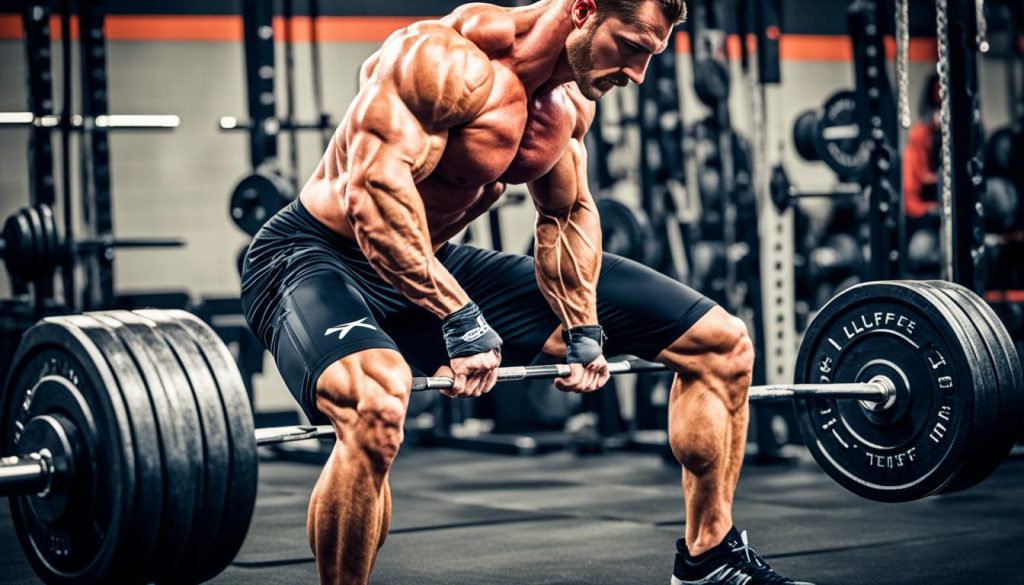
It’s crucial to do deadlifts correctly to get the most from them and avoid injuries. Let’s go through how to do a perfect deadlift:
- Set up your stance: Stand with your feet a little apart and toes outwards. Make sure the barbell is in the middle of your feet.
- Grasp the barbell: Bend at the hips and knees with a straight back. Hold the bar just wider than your shoulders with your palms down.
- Engage your core: Breath in deeply, tighten your stomach, and squeeze your bottom.
- Lift the bar: Push through your feet, straighten your legs, and stand up. Keep the bar close to your body as you lift.
- Lower the bar: To put the bar down, bend at your hips and knees with a straight back.
- Repeat: Do as many as you need with the right technique.
Deadlifts bring many advantages to your body and power:
- Enhanced muscle activation: They work many muscles all at once, boosting your glutes, hamstrings, and lower back especially.
- Improved functional strength: This means you’ll find daily tasks easier, like picking things up or moving stuff around.
- Increased muscle growth: As a full-body lift, deadlifts help grow muscles in the back of your body.
- Better posture and stability: They need a strong core, helping you stand tall and avoid back pain.
There are different types of deadlifts to try. Some focus more on certain muscles but carry the same benefits. Ask a fitness expert to pick the right one for you.
Romanian Deadlifts for Targeted Glute and Hamstring Activation
Romanian deadlifts are excellent for working your glutes and hamstrings. They are perfect for strengthening your back chain and boosting lower body power. Adding them to your workouts can really help your fitness levels.
The method for doing Romanian deadlifts is easy to follow. Start by standing with your feet apart, holding a bar or dumbbells in front of you. Keep your core tight and knees a bit bent. Make sure your back is straight and your shoulders are back. Lean at the hips while the weights lower, stretching your glutes and hamstrings well. When you feel the stretch, squeeze your glutes and hamstrings to stand back up. Do as many as you need.
Romanian deadlifts have other pluses besides working your glutes and hamstrings. They boost your hip stability, help you stand tall, and strengthen the lower back support muscles. They’re great for sports needing quick power, like sprinting and lifting.
You can try different types of Romanian deadlifts to keep your workouts fresh. These include lifts done on one leg, for extra glute and hamstring work and balance, and using dumbbells. The dumbbell version lets you move more and is good for newcomers or anyone with few tools.
To make the most of Romanian deadlifts, focus on doing them right and adding weight slowly. It’s key to do the exercise well rather than a lot. Always think about using your glutes and hamstrings as you work out.
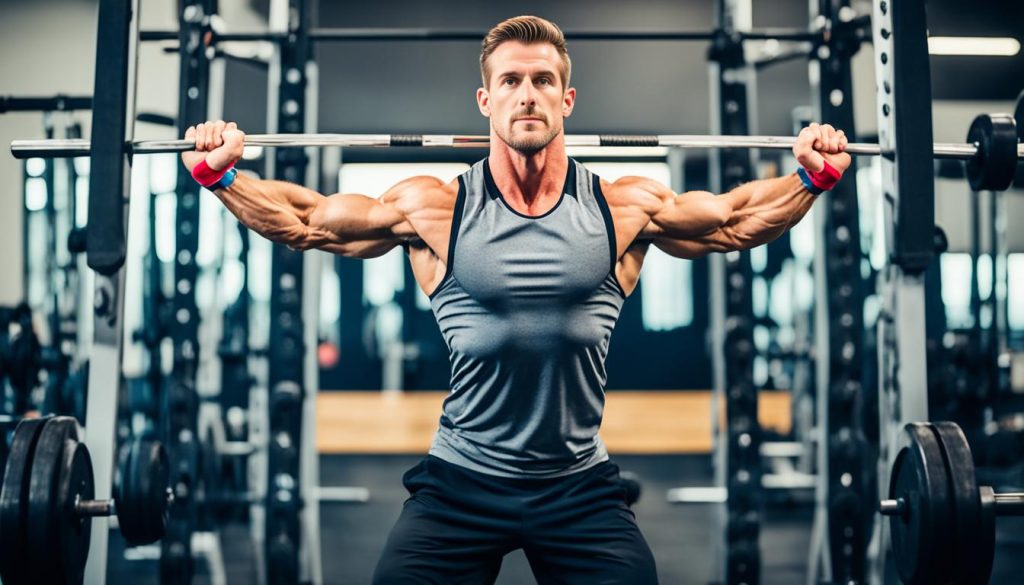
Glute Bridges: Strengthening the Lower Posterior Muscles
Glute bridges are great for your lower backside muscles, like the glutes. They work well and are simple to do. Both beginners and experts can benefit from them.
Here’s how to do a glute bridge:
- Start by lying on your back. Keep your knees bent and your feet flat on the floor, about hip-width apart.
- Next, tighten your stomach muscles and clench your glutes. Lift your hips until your body forms a straight line from knees to shoulders.
- Hold this pose for a few seconds. Then, lower your hips slowly to the start.
In glute bridges, your glutes are the main stars. They get stronger, which is good for your backside and body.
You can mix up your glute bridge routine with different types:
- Single-leg glute bridge: This kind focuses on each glute alone by lifting one leg off the ground when you lift your hips.
- Weighted glute bridge: Add a dumbbell or kettlebell to your hips to make the move harder. This means your glutes work more.
- Elevated glute bridge: Put your feet up on something like a bench. It gives you a bigger stretch and hits your glutes in a new way.
Working out with glute bridges has lots of pluses. It helps you:
- Get stronger glutes: Glute bridges aim right at your glutes, making them stronger all over.
- Stabilise your hips: This move makes your hip area more balanced. It helps your glutes and the other parts of your backside to work well together.
- Boost your sports skills: Solid glutes are key in sports. They bring more power, speed, and strength to your lower body.
- Ease back pain: Strong glutes can help with back pain. They give your spine more support and security.
Don’t forget glute bridges in your backside exercises. They really target your lower backside muscles well.
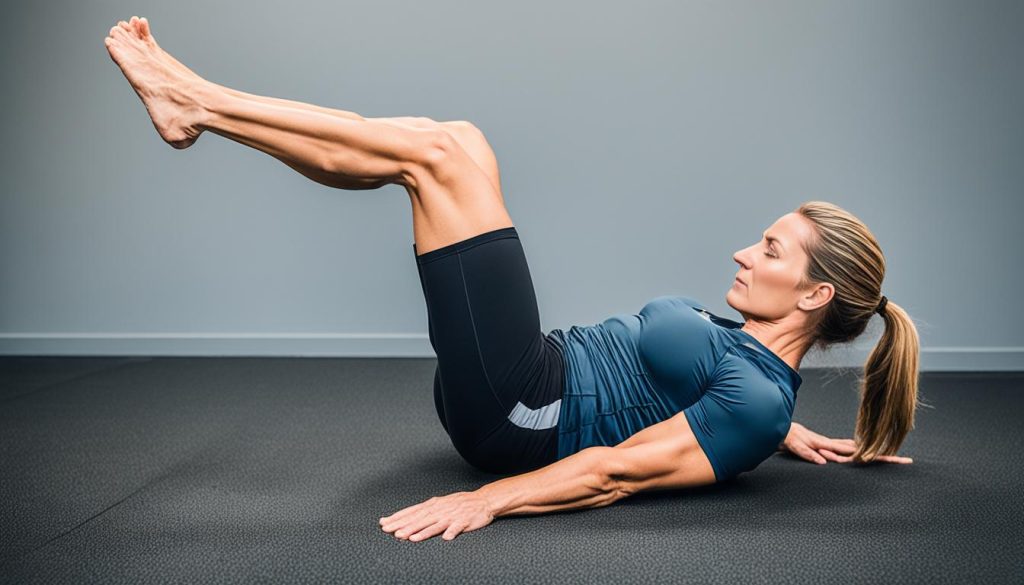
Mastering Squats for Comprehensive Posterior Chain Workouts
Squats are key for working out the back of your body, the posterior chain. They strengthen your glutes, hamstrings, and calves. By using many muscles at once, squats are a great choice for working all these areas together.
To do squats right, stand with your feet about shoulder-width apart. Tighten your tummy, keep your chest high, and your back straight. Then, slowly lower yourself like you’re sitting in a chair.
Try to keep your knees over your toes as you go down. This helps keep your body in a good line and safe from harm. Lower yourself until your thighs are flat with the ground if you can. After that, push up through your heels.
This action helps activate your glutes, hamstrings, and calves. Besides, it makes your lower body stronger and more stable. It also makes everyday movement easier.
If you want to change up your squat routine, there are many ways to do it. Goblet, front, and sumo squats do squats differently to focus on other muscles. This variety keeps your workouts interesting.
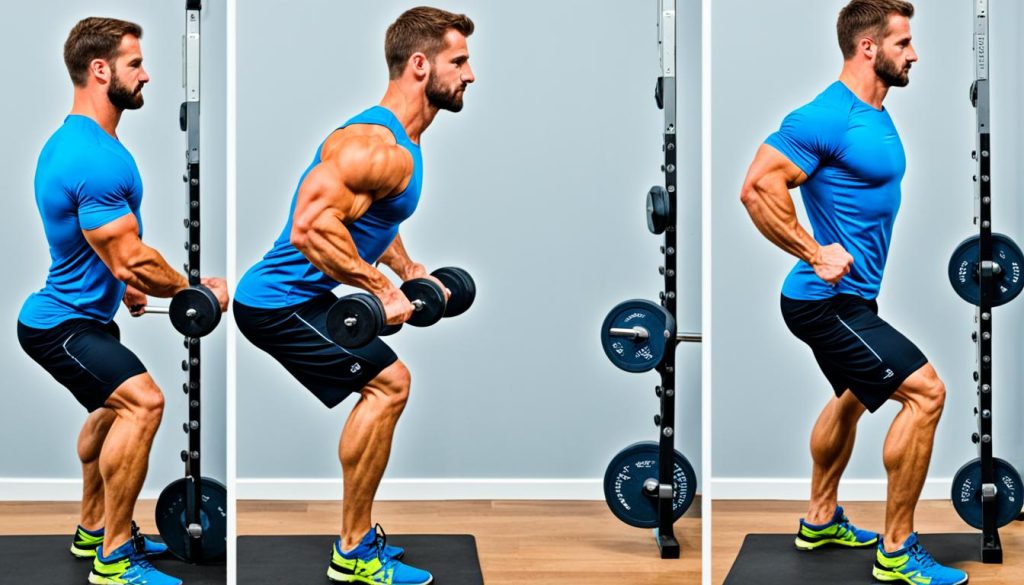
It’s so important to do squats the right way. This makes them work better and keeps you safe. If you’re not sure about your squat form, get help from a fitness expert. They can give you tips and advice.
Add squats to your training to build a strong, balanced back body. Squats are good for everyone, whether you’re just starting or are already lifting big. They help you reach your fitness goals and make you stronger and steadier.
Lunges and Their Role in Gluteus Maximus Development
Lunges are great for working out the gluteus maximus, the biggest muscles in your buttocks. They help a lot with strength, power, and staying steady on your feet.
To do a lunge, stand with feet wide apart. Step forward with your right foot. Make sure your knee is right above your ankle. Squat down so your right thigh is parallel to the floor. Keep your back straight and chest up. Push back up to your start and change to the left foot.
Lunges strengthen the gluteus maximus, helping you move better when walking or jumping. This boosts your lower body strength and power.
Lunges also work the hamstrings and calves. This helps with balance, stability, and how well you do in sports.
There are many types of lunges you can do. Try walking, reverse, or stay still and lunge. You can also hold weights or use bands to make it harder.
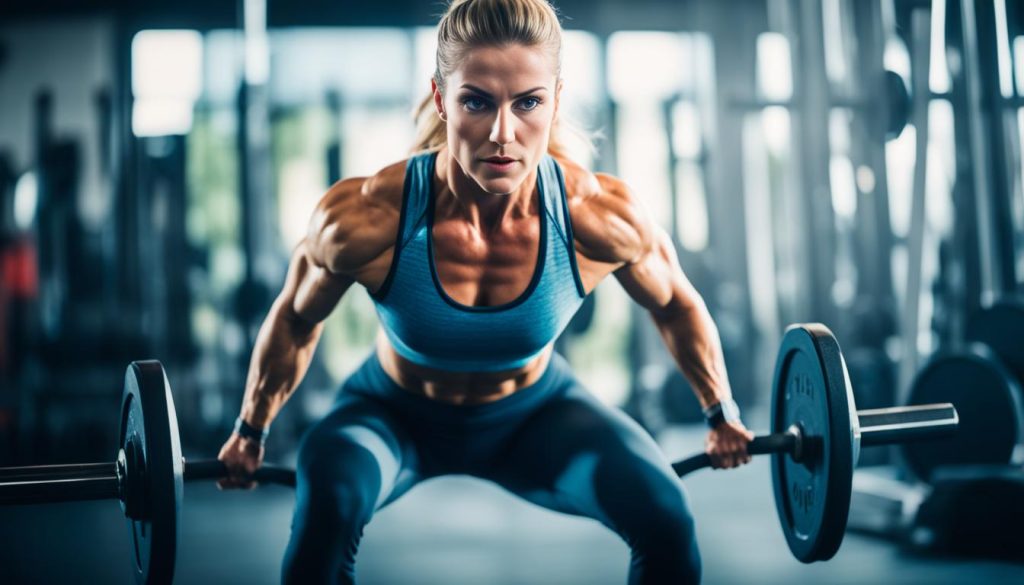
Start with light weights. Add more when you get stronger and better at it. Keeping the right form is key to working the muscles safely and without getting hurt.
In short, lunges are a top choice for working the gluteus maximus and strengthening the back of your legs. They help a lot with making your glutes better, improving your lower body strength, and doing well in sports.
Hamstring-Focused Movements: Leg Curls and Nordic Curls
Looking to work on your hamstrings and back legs? Try leg curls and Nordic curls. They target your hamstrings well. You’ll make your legs stronger and boost your back leg muscles.
Leg curls focus on the hamstrings. Lie down on a leg curl machine to start. Your upper body must stay still. Bend your knees, bringing your heels close to your glutes, and then straighten your legs again. Do this as many times as needed.
Nordic curls are tougher than leg curls and need very little gear. For Nordic curls, kneel on something soft. Have someone hold your ankles or fix them firmly. Lower your body slowly to the floor while keeping everything in line. Use your hamstrings to do this, and then raise your body back up. You can also do Nordic curls with a band to help.
Both kinds of curls help with your hamstrings and back legs. They make your hamstrings stronger and more toned. They also make your hamstrings more flexible, which helps in moving your legs better. Doing leg curls and Nordic curls makes activities like running, jumping, and lifting better because your legs will be powerful.
Remember, both leg curls and Nordic curls can be changed for different fitness levels. If you’re new, start the light and check your form. As you get better, you can use more weight or change things up to challenge yourself more.
Adding leg curls and Nordic curls to your routine does a lot for your hamstrings and back leg muscles. They work well and can fit anyone’s workout. These exercises will boost how well your back leg muscles work and make your routine more complete.
Calf Raise Variations for Complete Lower Leg Strengthening
Calf raises are key for making your lower legs stronger. They help not only your calves but also your soleus and tibialis posterior. Including various calf raise types in your workouts can really amp up your lower leg strength. Hence, improving stability. Here are some popular choices:
1. Standard Calf Raises
Standard calf raises are simple and great. Begin by standing upright with your feet apart and facing forward. Push up onto your toes, lifting your heels high, then lower slowly. Repeat this as many times as you like. These raises focus on the gastrocnemius, the big calf muscle.
2. Single-Leg Calf Raises
Single-leg calf raises are harder and focus on balancing. Stand on one leg and lift the other slightly. Push up as high as you can on your toes, then slowly lower. Do the set on one leg before switching. They boost your balance and fix any size differences between your calves.
3. Seated Calf Raises
This type targets the hidden soleus muscle. Sit down with feet flat, knees at right angles, and a weight on your thighs. Raise your heels off the ground, then lower. It’s a tough one for the soleus.
4. Donkey Calf Raises
Donkey calf raises need a machine or help. Go on your toes on a platform. Keep your back flat, leaning forward, with support. Lower your heels, then push up. They work the gastrocnemius and are great for heavy lifting to grow your calves.
5. Calf Raises on an Incline
Use an incline to hit your calves differently. Place your feet on it, heels hanging off. Lift up high and lower. This expands your motion and stretches your calves better.
Use these calf raise moves to make your lower body stronger, improve ankle support, and build up your back leg muscles. If you’re just starting, use light weights or just your body weight. Then, as you get stronger, add more weight or resistance gradually.
Conclusion
It’s key to add posterior chain exercises to your workout. They help build a robust back and boost your performance. These exercises work the backside muscles, like the glutes and hamstrings. By making these muscles stronger, you improve your balance, cut your risk of lower back pain, and help with daily tasks.
Improving your rear muscle power is super important. It keeps your strength up and fights the effects of aging on your muscles and bones. With the right exercises, your back grows stronger, and you get better at sports. Your quality of life also goes up.
Adding these workouts to your routine offers many pluses. They fix your posture, up your game in sports, and shape a better body. Whether you’re a pro athlete or just starting out, moves like deadlifts and squats are great. They offer a full workout for your backside.
In sum, focus on your rear muscle exercises to bolster your back and fitness. Doing these often brings a stronger back, better balance, and top performance in everything you do.
FAQs
What are posterior chain exercises?
Posterior chain exercises aim at the muscles on the backside of your body. This includes the glutes, hamstrings, and lower back. Strengthening these muscles improves overall strength and stability. It also helps prevent lower back pain.
What are the best exercises for the posterior chain?
Deadlifts and Romanian deadlifts are top choices. Also, consider glute bridges, squats, and lunges. For a full workout, add in leg curls, Nordic curls, and calf raises. All these exercises target the back muscles well. They can be changed to fit different fitness levels.
What are some effective posterior chain workouts?
For a good workout, mix different exercises that focus on the posterior chain. This might include deadlifts, squats, and lunges, among others. Also, add in glute bridges, leg curls, and calf raises. Such a mix fully activates and strengthens the back muscles.
How often should posterior chain activation drills be performed?
How much you should do these drills varies based on your goals and workout plan. For the best results, aim to do them two to three times a week. This should strengthen your back muscles well.

